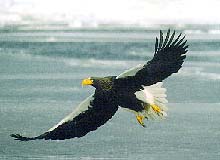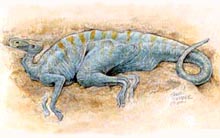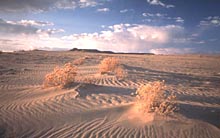|
|


Editorial
|
Fragments
|
Effigy Mounds I
|
Sea Serpents III
|
Atlantis III
Register
for our new Hall of Records Newsletter!
Questions? Comments? Suggestions? Advertising? Press Releases?
Contact us!
Secret Chamber
|
Thunderbird Sighting?
|
Dinosaur "Mummy"
|
Red Desert
|
Books


An image of
the Gantenbrink Door
from
iRobot's "Pyramid Rover"
robot, designed to search the shafts in the Great
Pyramid's "Queen's Chamber". This image shows the
robot about to insert a camera into a hole that had been
predrilled in order to expedite the
live telecast,
which took place worldwide on September 17, 2002. Unfortunately, the camera revealed neither golden treasure nor
ancient papyri, but yet another
"door".
Image copyright � 2002
National Geographic Channel/APTN.
|
|
On September 17, 2002, the
saga of the so-called "air shafts" in the Great Pyramid took yet
another tortuous twist. National Geographic, in conjunction with
Egypt�s Supreme Council of Antiquities headed up by Zahi
Hawass, aired a live, global telecast of the opening
of the "door" in the southern shaft in the so-called
"Queen's Chamber", one of three known chambers in the Great Pyramid.
Discovered by British
engineer Waynman Dixon in 1872, the shafts in the Queen's Chamber, one on
the north side of the chamber, and one on the south
side, are a bit of a mystery. The "King's Chamber", another, larger chamber
inside the pyramid above the Queen's Chamber, also has two shafts proceeding from it
pointing north and south, but these, unlike those
discovered in the Queen's Chamber, go clear to the
outside of the pyramid, which led some to believe that
they were intended to be airshafts.
In 1991, over a century
later, a German engineer by the name of Rudolf
Gantenbrink teamed up with the German Archaeological
Institute to investigate the largely unexplored shafts
in the King's and Queen's Chambers. As part of the
agreement with the Egyptian authorities, Gantenbrink
agreed to clean out the King's Chamber's shafts of all
the debris that had accumulated there, and to install a
ventilation system to decrease the temperature and
humidity within the pyramid that had been greatly
elevated by the huge number of tourists within the
pyramid.
Having completed this part
of his task, Gantenbrink built a robot specially designed to measure and
videotape the interior of both the King's Chamber and
Queen's Chamber shafts. The first version of the robot,
posthumously dubbed the "Father of Upuat" was a failure,
as it was made of inadequate materials. However, the
second version, "Upuaut" (lit., "Opener of the Ways")
was, with some modifications, successful. It was on this
third attempt in 1993, with the modified Upuaut robot
named "Upuaut II", that Gantenbrink discovered the
mysterious door in the southern shaft of the Queen's
Chamber that was featured on the National Geographic
special on 9/17/2002.
However, after the
discovery of the door, there was a sudden deterioration
in the relationship between the GAI and the Egyptian
authorities. As a result, Gantenbrink became
disheartened, and he abandoned the project until such
time that the situation improved. Unfortunately,
politics then replaced the search for truth in the
archaeological equation, and the Egyptian authority
refused to allow Gantenbrink to return and finish his
research, so tantalizingly close to what might have been a
major discovery.
As was discussed in Part III in our 1998-1999 series of
articles on The Riddle of the Sphinx, these so-called
"air shafts" are actually part of an extremely
sophisticated astronomical calendar that the ancient
Egyptians used to fix the date of the building of the
pyramids, among other things. However, mainstream
archaeologists disagree, particularly Mr. Hawass, whose
vitriolic attacks against alternative historians such as Robert
Bauval, Graham Hancock and John Anthony
West have become legendary. Fortunately, Mr. Hawass
is a highly responsible individual, and has promised to
make all of the discoveries inside the Great Pyramid and
elsewhere publically available which, in the end, is
what is most important. One question remains, however:
why was Gantenbrink not allowed to open the door way
back in 1993? Moreover, why was it not opened until
almost a decade later, why was Gantenbrink not the one hired to open it, and why was
it opened on Yom Kippur? Many questions remain
unanswered, as the story behind the search for the
secret chamber becomes as mysterious and intriguing as
the secret chamber itself.
Egypt is one of the most
popular tourist destinations in the world, and the Giza
necropolis in particular is probably the most famous
tourist destination in the world. There are numerous
excellent sites that offer travel tips and information on types of travel to Egypt. For more
information, contact the Egyptian Tourist Authority at
+20-2-2853576 or +20-2-2859658, or visit Tour
Egypt, Egypt's official tourism site. 



 The Upuaut Story
The Upuaut Story
 (Point) The Daily Grail: Doors of
Deception
(Point) The Daily Grail: Doors of
Deception
 (Counterpoint) Middle East Times: Egypt
Strikes back at Pyramid Theorists
(Counterpoint) Middle East Times: Egypt
Strikes back at Pyramid Theorists
 The Dramatis Personae:
The Dramatis Personae:
 Rudolf
Gantenbrink
Rudolf
Gantenbrink
 The Plateau: The Official Website
The Plateau: The Official Website
for Dr.
Zahi Hawass
 Robert
Bauval: Official Website
Robert
Bauval: Official Website
 The
Official Graham Hancock Website
The
Official Graham Hancock Website
 The Official
Website of
The Official
Website of
John Anthony West
 Mark Lehner, Archaeologist
Mark Lehner, Archaeologist
 Guardian's Egypt: Egypt Team Finds New
Mystery Door in Pyramid
Guardian's Egypt: Egypt Team Finds New
Mystery Door in Pyramid
 Ancient Egyptian Chambers
Explored
Ancient Egyptian Chambers
Explored
 Third "Door" Found in Great
Pyramid
Third "Door" Found in Great
Pyramid
 National Geographic: Secrets of
Egypt
National Geographic: Secrets of
Egypt
 Pyramid Robot Finds Another
"Door"
Pyramid Robot Finds Another
"Door"
 Egypt Plans New Hunt for Clues to Pyramid
Doors
Egypt Plans New Hunt for Clues to Pyramid
Doors
 Al-Ahram: The Pyramid Mystery
Al-Ahram: The Pyramid Mystery
 TV's 'Pyramid Scheme' Comes up
Dry
TV's 'Pyramid Scheme' Comes up
Dry
 Guardian's Giza: The Queen's
Chamber
Guardian's Giza: The Queen's
Chamber
 MSN: Pyramids (Egypt)
MSN: Pyramids (Egypt)
 University of Chicago's Virtual
Giza
University of Chicago's Virtual
Giza
 Crystal Links: Great Pyramid
Schematics
Crystal Links: Great Pyramid
Schematics
 The Sphinx Temple: Interactive
Movies
The Sphinx Temple: Interactive
Movies
 NOVA/Pyramids: The Inside Story
NOVA/Pyramids: The Inside Story
 Tour
Egypt: Egypt's Official Tourism Site
Tour
Egypt: Egypt's Official Tourism Site
 TourismNet: Egypt
TourismNet: Egypt
 Five
Star Egypt Tourism
Five
Star Egypt Tourism
 Egyptian Tourist Authority
Egyptian Tourist Authority
 Map of
Egypt
Map of
Egypt
|
|
|


A Steller's Sea Eagle, one possible
candidate for the mysterious large, black bird recently
seen in Alaska, which some are calling a reappearance of
the Thunderbird. Image from Foundation for Agrarian Development Research
(Russia). |
|
A large, dark, flying creature has been seen soaring
high in the skies over southwest Alaska in recent
months. Residents say that the creature is exceptionally
large, much larger than even the bald
eagle, which has a wingspan of 6-7 feet. Bald eagles
are found all over the United States, but are most
common in the Pacific Northwest and particularly common
in Alaska, so residents of Alaska are unlikely to
mistake it for something as large as the creature that
has been reported.
This "massive bird" was described by the
residents of Togiak and Manokotak as "like something out
of 'Jurassic Park,' " with a wingspan easily
14 feet wide, possibly even wider — much bigger than
anything else they have seen before. A heavy equipment
operator working in the field by the name of Moses
Coupchiak was one of the people who spotted the
creature, thinking at first that it was a small
airplane. "At first I thought it was one of those
old-time Otter planes," Coupchiak said. "Instead
of continuing toward me, it banked to the left, and
that's when I noticed it wasn't a plane." The mystery
creature was also spotted by the pilot of a Cessna 207 who estimated that the
creature's wingspan was approximately the same as one of
his plane's wings, which is 14 feet — twice as long as
that of the typical bald eagle. Passengers on the plane
were also astounded by its size, and one passenger
described it as being large as "a little Super Cub" airplane.
Scientists are of course skeptical that such a huge
bird could exist, though birds of such size did exist in
ancient times. Federal raptor specialist Phil Schemf was
quoted as saying "I'm certainly not aware of anything
with a 14-foot wingspan that's been alive for the last
100,000 years." The prehistoric bird that Schemf was
likely referring to is the Teratorn, a type of giant vulture related
to the California condor. The teratorn went
extinct at the end of the Pleistocene Age, most likely due to the
decrease in large carcasses � such as the woolly mammoth � that it needed to feed
on, as its massive beak was unsuitable for predating
smaller carcasses. The teratorn's 14-foot wingspan,
however, makes it a good candidate for the "massive
bird", though it of course has been extinct for
thousands of years.
Another possible explanation for the mysterious,
massive bird is that it was a "Steller's sea eagle", a type of eagle
common to the northern Pacific, and which had been
recently spotted in Alaska. However, though the
Steller's sea eagle, with its 8-foot wingspan, is larger
than the typical bald eagle, it is still far smaller
than the dark creature witnesses described. Moreover,
the Steller's sea eagle is not completely black as the
eyewitnesses had described the mysterious creature, and
it has a very distinctive, bright yellow beak, which was
not mentioned by any witnesses. And at 8 feet, its
wingspan is large, but not large enough to be described
as "really, really big".
In our Autumn, 1999 issue of Mysterious World,
we published an article entitled "The Fabulous Thunderbird", about a
similarly large bird that is prominent in the Native American myths of the Winnebago
Indians of the northern Midwest and Plains states, from
the Passamaquoddy Indians of Maine, and of the
Quillayute, who lived near Seattle, Washington. In their
myths, the Thunderbird was described as a huge, powerful
creature, so strong that it could carry a small whale in
its talons. The Thunderbird of the Native American
legends was more than just a bird, however � to them the
Thunderbird was a semi-divine creature which displayed
supernatural characteristics. In their myths, the Thunderbird
was the cause of thunder and lighting, using lightning to
kill and devour its prey on earth, the
following thunder caused by the loud flapping of its
enormous wings. The Thunderbirds's favorite prey were
the Waterspirits, which looked and acted much
like the mythical Piasa Creature spoken of in other Native
American myths.
Based upon the description of the Thunderbird in the
Native American myths, we suggested that the Thunderbird
may have actually been another prehistoric creature
known as Quetzalcoatlus Northropi, the
largest known flying creature ever to stalk Earth's
skies. Quetzalcoatlus is a good candidate for the
Thunderbird, as its 35-foot wingspan would allow it to
actually carry off a small whale, as was described in
the Quillayute myths. However, the sightings tended more
towards the idea that the creature is a more like a
"giant eagle" with no distinctive characteristics other
than its great size.
For more information on what to do and where to go to
find this mysterious creature, or if you are simply
interested in visiting one of America's most scenic
states, please visit the Alaska
Travel Industry Association, or contact them at the
following address: Alaska Travel Industry Association,
2600 Cordova Street, Ste. 201, Anchorage, AK 99503;
email: travelalaska@alaskatia.org;
website: http://www.travelalaska.com/.



 Southwest Alaskans See Bird They Say is Super
Cub-Sized
Southwest Alaskans See Bird They Say is Super
Cub-Sized
 Massive bird spotted in Alaska
Massive bird spotted in Alaska
 A Super-Sized Bird in Alaska
A Super-Sized Bird in Alaska
 American Bald Eagle Information
American Bald Eagle Information
 Teratorns (Teratornis spp.)
Teratorns (Teratornis spp.)
 California Condor
California Condor
 Species Synopsis: Steller's Sea
Eagle
Species Synopsis: Steller's Sea
Eagle
 Ecophoto: Steller's Sea Eagle
Ecophoto: Steller's Sea Eagle
Quetzalcoatlus Northropi
 Thunderbirds or Thunders (Wak'�dja, "The
Divine Ones") [Winnebago Version]
Thunderbirds or Thunders (Wak'�dja, "The
Divine Ones") [Winnebago Version]
 "The Origin of the Thunderbird"
[Passamaquoddy version]
"The Origin of the Thunderbird"
[Passamaquoddy version]
 The Thunderbird [Quillayute version]
The Thunderbird [Quillayute version]
 The Dinosauricon: Quetzalcoatlus
Northropi
The Dinosauricon: Quetzalcoatlus
Northropi
 Wierd Predators: The Thunderbird
Wierd Predators: The Thunderbird
 Alaska
Travel Industry Association
Alaska
Travel Industry Association
 Alaska Division of Tourism
Alaska Division of Tourism
 Alaska Tourism and Travel Guide
Alaska Tourism and Travel Guide
 Alaska
Wilderness Recreation & Tourism
Association
Alaska
Wilderness Recreation & Tourism
Association
 State of
Alaska: Official Site
State of
Alaska: Official Site
|
|

|


An unusually well-preserved specimen of a
brachylophosaurus,
recently discovered in Montana. Nicknamed "Leonardo", the find is
the best preserved dinosaur fossil found to date. Above is an onsite restoration drawing of how Leonardo may have looked before
burial based on observations of the specimen and stratagraghic, taphonomical data. The drawing was done by paleolife artist Greg
Wenzel. Copyright 2001,
Judith River Dinosaur Institute.
|
|
On July 27, 2000, a very unusual dinosaur fossil was discovered near
Malta, Montana.
This specimen, that of a duck-billed herbivore called a "brachylophosaurus", was unusual in that the dinosaur appears to have been
"mummified" by natural processes before fossilization took place, resulting in a fossil of exceptionally high quality. Not only are
almost all of the bones intact and preserved, but most of the vital organs, skin and even the contents of the stomach are preserved.
As Nate Murphy, the Curator of Paleontology at the
Phillips County Museum,
where Leonardo is on display, explained, "For paleontologists, if you can find one complete specimen
in a lifetime, you've hit the jackpot ... to find one with so much external detail available, it's like going from a horse and
buggy to a steam combustion engine. It will advance our science a quantum leap."
Leonardo had been discovered during one of the
Judith River Dinosaur Institute's
expeditions, and became the focus of the Institute's 2001 season. As they excavated the dinosaur, they confirmed that Leonardo
was a 22-foot-long subadult, weighing between 1.5 to 2 tons, and that the diet at the time of his death consisted of ferns,
conifers, and magnolias. The skin was also well preserved, and showed evidence of scales ranging in size from a BB to a dime, as
well as a sail frill running up his back. To understand the extremely high quality of this find, one need only understand that
less than one-tenth of one percent of all fossilized dinosaur finds have any soft tissue remains, let alone the 90+ percent
coverage present with the Leonardo discovery.
The environment and circumstances under which this sort of "mummification" process can take place are also extremely rare.
Leonardo's body had to be in an area that was safe from predators and that caused a rapid burial so that the body could be
protected from the elements. Paleontologists have come to the conclusion that the brachylophosaurus died on the edge of a
river or perhaps on a sand bar, as the body appears to have been buried very rapidly.
Leonardo is currently
on display
at the
Phillips County Museum
located in
Malta, Montana.
For more information and directions on how to visit Leonardo, contact the
Malta, Montana Chamber of Commerce at
(406) 654-1776, or email them at malta@ttc-cmc.com.



 Dinosaur Fossil Shows Some Skin
Dinosaur Fossil Shows Some Skin
 The Judith River Dinosaur Institute
The Judith River Dinosaur Institute
 Phillips County Museum
Phillips County Museum
(Leonardo Exhibit)
 "Mummified" Dinosaur Discovered
"Mummified" Dinosaur Discovered
In Montana
 Fossil in the Flesh: A Spectacular New Dinosaur Mummy
Fossil in the Flesh: A Spectacular New Dinosaur Mummy
 The Dinosauricon: Brachylophosaurus
The Dinosauricon: Brachylophosaurus
 DinoData: Brachylophosaurus
DinoData: Brachylophosaurus
 Skin Impressions from the Tail of a Hadrosaurian Dinosaur
Skin Impressions from the Tail of a Hadrosaurian Dinosaur
 The Wyoming Dinosaur Center
The Wyoming Dinosaur Center
 Malta, Montana: Chamber of Commerce
Malta, Montana: Chamber of Commerce
 Online Highways: Malta, Montana
Online Highways: Malta, Montana
 Malta, Montana: Lodging
Malta, Montana: Lodging
 The Mummy Tombs: Dinosaur Mummies
The Mummy Tombs: Dinosaur Mummies
 Dinosaur National Monument (Colorado)
Dinosaur National Monument (Colorado)
 Dinosaur World
Dinosaur World
 The Dinosaur Depot
The Dinosaur Depot
 Smithsonian National Museum
Smithsonian National Museum
of Natural History
 The Dinosaur Museum
The Dinosaur Museum
 The Dinosauria
The Dinosauria
 Dinosaur State Park
Dinosaur State Park
|
|
|


The "Red Desert", located in southwestern Wyoming, is the largest area
of unfenced area of land in the United States, where a
man can ride for three days and never open a gate. A
classic, high plains "cold desert", the Red Desert is
anything but deserted, supporting an amazing variety of wildlife, and is
literally "where the deer and the antelope play". Image
by Scott T. Smith, adapted from Llander Llama Company. |
|
The words "Red Desert" may conjure up visions of an
exotic region on the red planet Mars. Yet, there is such
a place here on earth, and it's in America's own
backyard.
America's Red Desert can be found along both sides of
Interstate Highway 80 in southwestern Wyoming. This vast expanse
of dry, red soil and moving sand dunes covers much of
the 108 miles between Rawlins and Rock Springs and extends some 30 miles
north and south of I-80.
The area is harsh but is filled with stark beauty and
many places of interest. There is, for instance, an
impressive volcanic monolith called the "Boar's Tusk", which rises 400 feet above
a valley floor 28 miles north of Rock Springs. And there are the "Honeycomb Buttes", one of the red
desert's more scenic areas, where wild horses have been seen.
Canyon walls in the Red Desert contain strange petroglyphs and pictographs. There are
additional inscriptions at a place called Castle Gardens 60 miles to the north.
Petroglyphs and pictographs at this site, which is near the town of Moneta on Highway 20/26, have been said
to resemble features on ancient Roman coins. And,
finally, there is evidence that an unknown people lived
in the region 7,000 years ago.
There is much to see and wonder about in this unique
land. In some ways, the "Red Desert" is as mysterious as
the "Red Planet" Travelers planning to visit sparsely
populated areas, such as the Red Desert, should
determine in advance the kind of vehicle, clothing,
equipment and supplies needed to ensure a safe and
pleasant experience. For further information, contact
the following offices:
Rawlins Chamber of Commerce/Carbon County
Visitors Council
519 W. Cedar, P.O. Box
1331
Rawlins, Wyoming 82301
(307)324-4111 or
(800)228-3547
Email: jmoyer@trib.com
Website: http://www.oldwestfun.com/
Rock Springs Chamber of Commerce
1897
Dewar Dr., P.O. Box 398
Rock Springs, Wyoming
82902
(307)362-3771 or (800)463-8637
Email: rschamber@wyoming.com
Website: http://www.rockspringswyoming.net/ 


 Mapquest: Red Desert Region
Mapquest: Red Desert Region
 National Wildlife Federation: Red
Desert
National Wildlife Federation: Red
Desert
 OnEarth: The Last Lonesome Place
OnEarth: The Last Lonesome Place
 Wyoming Outdoor Council: Red Desert
Dreams
Wyoming Outdoor Council: Red Desert
Dreams
 Wyoming Outdoor Council: Wyoming's Red Desert
(Photos)
Wyoming Outdoor Council: Wyoming's Red Desert
(Photos)
 The Red Desert: Wyoming's Endangered
Country
The Red Desert: Wyoming's Endangered
Country
 The Wyoming Companion
The Wyoming Companion
 Carbon County, Wyoming
Carbon County, Wyoming
 Lodging in Carbon County
Lodging in Carbon County
 Red Desert, Wyoming - What A
Place!
Red Desert, Wyoming - What A
Place!
 Online Highways: Red Desert
Online Highways: Red Desert
 Online Highways: Red Desert: Natural
Features
Online Highways: Red Desert: Natural
Features
 Wild Colorado: Wyoming's Red
Desert
Wild Colorado: Wyoming's Red
Desert
 Travel-Wyoming.com
Travel-Wyoming.com
 Travel-to-Wyoming.com
Travel-to-Wyoming.com
 Bed & Breakfast Inns and Ranches of
Wyoming: Red Desert
Bed & Breakfast Inns and Ranches of
Wyoming: Red Desert
 Western
Encounters: Wyoming Horseback Riding and Camping
Adventures
Western
Encounters: Wyoming Horseback Riding and Camping
Adventures
 Lander
Llama Company: Wilderness Hiking Adventures
Lander
Llama Company: Wilderness Hiking Adventures
 Wyoming History at Western Wyoming
College
Wyoming History at Western Wyoming
College
|
|
Secret Chamber
|
Thunderbird Sighting?
|
Dinosaur "Mummy"
|
Red Desert
|
Books
Editorial
|
Fragments
|
Effigy Mounds I
|
Sea Serpents III
|
Atlantis III
Register
for our new Hall of Records Newsletter!
Questions? Comments? Suggestions? Advertising? Press Releases?
Contact us!



 Secret Chamber: The Quest for the Hall of Records
Secret Chamber: The Quest for the Hall of Records
Robert Bauval
Rating:




Robert Bauval was the first to truly begin to solve the Riddle of the Sphinx in his classic book, "The Orion Mystery." Since then, other prominent authors, including most notably Graham Hancock, have picked up the ball on the question of the Riddle of the Sphinx, focusing their efforts not only on defining what the Riddle means, but what its answer is. Inevitably, all come to the same conclusion, that the answer to the Riddle of the Sphinx is that the pyramids and Sphinx form a vast, three-dimensional treasure map, where X marks the spot on a mysterious Secret Chamber somewhere in the Giza necropolis. This chamber is believed to house an ancient Hall of Records which contains knowledge of the ancient world before the Flood, so naturally archaeologists, historians, and those interested in history in general are keen to discover the ancient Secret Chamber, if it truly exists. Bauval performs an admirable job of chronicling all the major and many of the minor players who have taken part in the quest for the Hall of Records, though I would have preferred more revelations concerning the current search for the Hall. Unfortunately, the recent lockdown by the Egyptian government on additional archaeological research in the Giza plateau has made this impossible. So, rather than relying on speculation to fill out a new book on the subject, Bauval decided to pause and chronicle all the relevant research to this point, a decision that was not only necessary, but appropriate.
Click
here
to buy this book.
 Lonely Planet Egypt
Lonely Planet Egypt
Humphreys Andrew, Siona Jenkins, Andrew Humphreys
Whether you want to cruise down the Nile, explore ancient sites or soak up the sun in Sinai, this guide is the perfect companion
for exploring Egypt - a land that has tempted travellers for centuries.
 104 detailed maps, including a full-colour country map 104 detailed maps, including a full-colour country map
 Special section on Pharaonic Egypt, including a who's who of gods & goddesses and
a user's guide to reading hieroglyphs Special section on Pharaonic Egypt, including a who's who of gods & goddesses and
a user's guide to reading hieroglyphs
 The lowdown on camel trekking in Sinai, desert safaris and felucca trips The lowdown on camel trekking in Sinai, desert safaris and felucca trips
 Up-to-date advice on where to stay and eat on any budget Up-to-date advice on where to stay and eat on any budget
 Hot tips on where to dive and snorkel in the Red Sea Hot tips on where to dive and snorkel in the Red Sea
(Review by Amazon.com)
Click
here
to buy this book.
 Shadow of the Thunderbird
Shadow of the Thunderbird
D. L. Tanner
For the Past 160 years, giant birds have been sighted in the skies above the Black Forest region of northern Pennsylvania.
Now, it's up to one man and one woman to find out where they came from and where they've gone ...
In the tradition of Michael Crichton's "Jurassic Park" and Douglas Preston & Lincoln Childs' "Relic", "Shadow of the Thunderbird"
is the story of fledgling cryptozoologist Ian McQuade. A professional student well into his twenties, he alienates his Ph.D.
advisor by attempting to submit a doctoral disseration on the reality of Thunderbirds. The symbolic totem of many Native American
cultures, he finds no support for his theories and ends up taking a low paying job as the assistant curator of a lesser known museum
of natural history. When the opportunity presents itself, he takes his vacation time and life savings to conduct an expedition
into the deforested Amazon Basin of western Brazil. Hoping to discover and classify a rare breed of giant crimson spider, he finds
himself instead broke, lost and utterly stranded without a job in South America. Rescued by a beautiful Peruvian cartographer
and archaeologist, Ian accompanies Alma Del Nephites to New York for a meeting with her employer, the enigmatic CEO of a secretive
philanthropic organization. Hired to search for the legendary birds in the Black Forest region of northern Pennsylvania, together
they will embark on a mission that becomes a quest to follow the diary of a madman into the heart of an 800 year old mystery.
Pursued by the agents of a sinister competitor, Ian is forced to confront his past to believe in a future that couldn't possibly exist.
Click
here
to buy this book.
 Alaska Off the Beaten Path
Alaska Off the Beaten Path
Melissa Devaughn
Whatever you do when you travel, get off the highway. Who needs more bland rest stops and fast food? Get into the heart
of things with Globe Pequot's Off the Beaten Path series. Devoted to travelers with a taste for the unique, this easy-to-use
guide helps you discover the hidden places in Alaska that most tourists miss - unsung, unspoiled, and out-of-the-way finds
that liven up a week's vacation, a day trip, or an afternoon. (5 1/2 X 81/2, 240 pages, maps, illustrations)
(Review by Amazon.com)
Click
here
to buy this book.
 National Geographic Dinosaurs
National Geographic Dinosaurs
Paul M. Barrett, Kevin Padian (Introduction), Raul Martin (Introduction)
Paul Barrett's National Geographic Dinosaurs, illus. by Raul Martin, catalogues more than 50 of the "terrible lizards."
A "time bar" running along the outside of the page indicates the period for each particular dinosaur; a "Fact File" provides
the animal's genus, classification, weight and measurements; and a graph compares the dino's size to humans. Other sections
focus on the Mesozoic through the Cretaceous period, paleontology and dinosaur behavior. Over 300 full-color photographs and
90 photorealistic illustrations add dimension. (Review by Amazon.com)
Click
here
to buy this book.
 The Scientific American Book of Dinosaurs
The Scientific American Book of Dinosaurs
Gregory s Paul (Editor)
Discover how dinosaurs evolved, how they looked, where they lived, how they behaved, and why they died: the current state of
knowledge about the Monsters of the Mesozoic, complete in one volume. Acclaimed dinosaur paleontologist and paleo-artist Gregory S. Paul
conducts this definitive tour through the 140-million-year existence of the most exotic and interesting group of animals ever to walk
the earth, assisted by the world's leading dinosaur experts. Here you'll find remarkable stories about the first discoveries of
dinosaur fossils, the beginnings of dinosaur paleontology, how the field has changed with modern technology, the most sensational
finds, and the latest theories. (Review by Amazon.com)
Click
here
to buy this book.
 Atlas of the Prehistoric World
Atlas of the Prehistoric World
Douglas Palmer
The earth is not the spring chicken it was 4.6 billion years ago. With the passing of the millennia, earth's face, weathered by
heat and ice and subject to tectonic friction, has erupted, wrinkled, and sagged, as do all our faces ultimately, only more so.
Continents have shifted, merged, and split apart. Seas have turned to land and land has been submerged by seas. And microorganisms
have evolved into the vast diversity of flora and fauna that exists today. Douglas Palmer's Atlas is a digest of what is known so
far about the history of the earth, enhanced with brilliant maps, photographs, and illustrations, and explained in lucid,
enjoyable prose. (Review by Amazon.com)
Click
here
to buy this book.
 Off the Beaten Path Montana: A Guide to Unique Places
Off the Beaten Path Montana: A Guide to Unique Places
Michael McCoy, Carole Drong (Illustrator)
A fascinating mix of attractions awaits the Montana traveler, from the Big Montana Sheep Drive to the Little Bighorn Battlefield.
6 maps, 12 illustrations
(Review by Amazon.com)
Click
here
to buy this book.
 Wyoming Off the Beaten Path: A Guide to Unique Places
Wyoming Off the Beaten Path: A Guide to Unique Places
Michael McCoy
Whatever you do when you travel, get off the highway. Who needs more bland rest stops and fast food?
Get into the heart of things with Globe Pequot's Off the Beaten Path series. Devoted to travelers with a
taste for the unique, this easy-to-use guide will help you discover the hidden places in the Wyoming that
most tourists miss - unsung, unspoiled, and out-of-the-way finds that liven up a week's vacation, a day trip,
or an afternoon. Native or newcomer, use this guide to find historical and cultural information, detailed
maps and driving directions, admission fees and hours of operation, restaurants, places to stay and much more.
(Review by Amazon.com)
Click
here
to buy this book.
Editorial
|
Fragments
|
Effigy Mounds I
|
Sea Serpents III
|
Atlantis III
Register
for our new Hall of Records Newsletter!
Questions? Comments? Suggestions? Advertising? Press Releases?
Contact us!
|
|
















 Secret Chamber: The Quest for the Hall of Records
Secret Chamber: The Quest for the Hall of Records Lonely Planet Egypt
Lonely Planet Egypt Shadow of the Thunderbird
Shadow of the Thunderbird Alaska Off the Beaten Path
Alaska Off the Beaten Path National Geographic Dinosaurs
National Geographic Dinosaurs The Scientific American Book of Dinosaurs
The Scientific American Book of Dinosaurs Atlas of the Prehistoric World
Atlas of the Prehistoric World Off the Beaten Path Montana: A Guide to Unique Places
Off the Beaten Path Montana: A Guide to Unique Places Wyoming Off the Beaten Path: A Guide to Unique Places
Wyoming Off the Beaten Path: A Guide to Unique Places